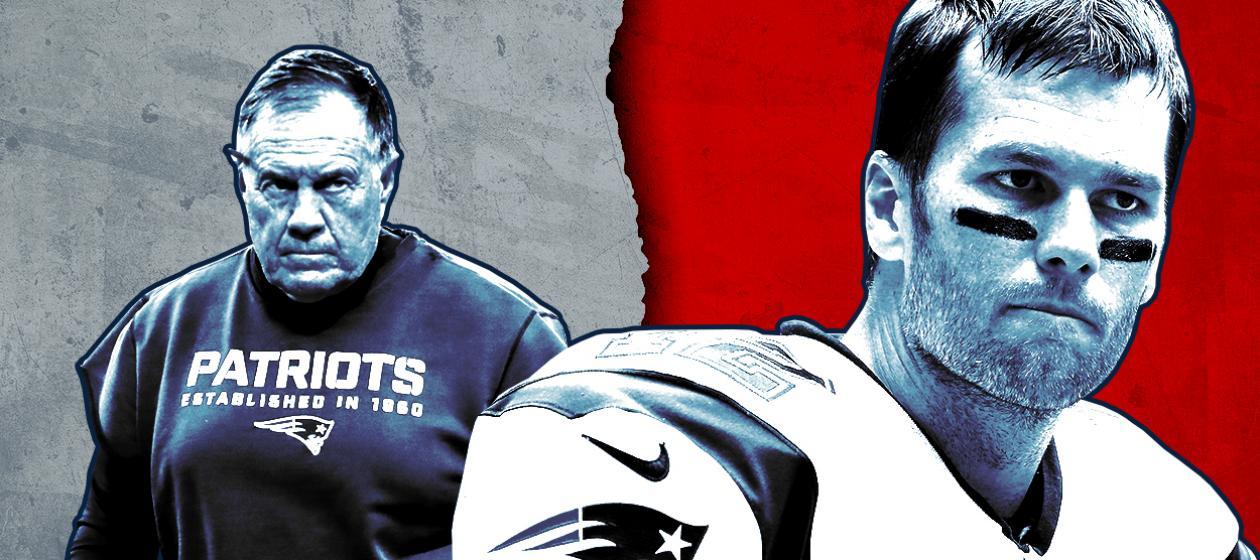This is the second article based on the 2020 book titled Dynasty about the complicated relationship between Bill Belichick and Tom Brady, who led the New England Patriots to six Super Bowl titles.
When he became head coach of the team in the year 2000, Belichick’s first priority was cutting players he didn’t want. He craved intangible qualities such as leadership, discipline, and toughness. Of the 53 on the roster, he inherited only about a dozen suited his needs.
From there he started building a squad aligned with his vision. He wanted guys on defense who exuded extreme toughness and hyper-competitiveness.
Rodney Harrison’s intensity
In 2002 he spotted one guy who fits perfectly. As the Patriots warmed up for a game against the San Diego Chargers, he noticed the team’s safety, Rodney Harrison, get in a fight with one of his teammates. Harrison had become known as one of the hardest hitters in the league. Belichick made a note that he had to have that guy.
So he went after him. The complication was he already had an All-Pro at safety, Lawyer Milloy, who was also the team captain. Still, Belichick traded him so he could get Harrison. Releasing Milloy caused a big stir on the team because he was a star player and well-liked team leader. For the next 19 years, Belichick would let go of star players with regularity at a pace unmatched by any other NFL coach in history.
“Today is a day that nobody’s happy about,” he said publicly. “This isn’t the way we wanted this story to end. This is the hardest player that I have had to release. It was the hardest situation that I’ve had to go through like this, here or anywhere else.”
Sticking to his decision, however, he gushed about Harrison’s world-class tenacity and fierce approach to preparation: “He wasn’t a cheap player. He was an aggressive player. And he was a great player. When they’re on your team, you appreciate them and you love their toughness. You love their competitiveness. When they’re on the other team, you can be a little offended by it.”
In practice, Harrison knocked down and taunted anyone in his path – including Brady. “The best practice player, probably ever,” Belichick said. “Ruffled a few features, not in a dirty way. Just in a highly competitive way. He made everybody else better.”
Belichick impressed by McGinest fighting lineman
The coach also made sure to draft Willie McGinest, a USC linebacker who, Belichick noted, had in 1996 engaged in a fight with a much bigger defensive lineman on his team. McGinest swang first. That lineman didn’t mess with him again. Belichick had to have him.
Chasing Brady
As the 2000 draft approached, Belichick’s scout started telling him about a quarterback out of the University of Michigan who would fit well in the Patriots system: Tom Brady.
Studying the film, Belichick became intrigued that every time Brady’s team needed him to perform well under pressure, he did. Although not widely heralded as a first-round pick, Belichick had an instinct about the kid Brady. This even though the unheralded quarterback had posted some of the lowest scores that year among all players in the draft measured by overall athletic ability.
No one had selected him as the sixth round began. Belichick didn’t understand why because he believed the young man had potential largely because of his mental toughness and strong performance in pressure situations.
For their part, New England’s coaching staff couldn’t understand why Belichick wanted to draft a quarterback because the team already had an All-Pro leading the team, Drew Bledsoe. The Patriots drafted Brady in the sixth round.
The fact that Belichick saw something unusually appealing about Brady watching his college football tapes proved to be one of the shrewdest and most perceptive insights any coach at any level has ever had. Not a great athlete by any statistical measure, Belichick still saw something very special. And early in his career with the Patriots, Belichick named Brady the starter even though Bledsoe was performing at an All-Pro level. Again, many disagreed with the coach’s decision, but he proved them all wrong.
“Not afraid to get rid of anybody”
Belichick had clear ideas of the kinds of players he wanted and didn’t, and when he wanted to cut them.
“He’s not afraid to get rid of anybody, no matter how important a person is, no matter how valuable people on the street might think he is,” said his former offensive coordinator Charlie Weis. “He’s never afraid to make a change or a move that might be perceived as unpopular.”
Mike Vrabel, one of the team’s star players who Belichick ultimately cut, said: “You play for Belichick and every week’s a tryout.”
Lee Johnson, the team’s punter in those early years with Belichick, lived through this Belichick pressure cooker firsthand. A few days after mishandling a snap, fumbling the ball, and allowing the other team to run it in for a touchdown, Belichick called him into his office.
“We’re letting you go. You’re slipping.”
The coach said nothing else even though he had become one of the best punters in the team’s history.
Bad footballs
The coach’s toughness permeated the entire way they operated. Detailed preparation under difficult, stressful circumstances was the norm even extended to the actual footballs they used in practice.
“The balls we practice with are as bad as they can be,” said Belichick. “Wet. Sticky. Cold. Slippery. However bad we can make ‘em, I make ‘em. And anytime that players complain about the quality of the balls, I make ‘em worse.”
The book explains that Belichick required selflessness and firm focus on details because of his military upbringing as the son of the head football coach at the U.S. Naval Academy.
“By the time I got out of high school, that’s all I knew. I didn’t have a perspective on selfish players or guys who didn’t want to do what they were supposed to do. That didn’t exist at the Naval Academy and it didn’t exist in Annapolis. When you grow up that way and that’s all you see, then it influences you and your philosophy because it’s all you know.”
Leadership and winning came with a price
While his approach won a ton of games, his austere approach had its downsides. The author writes:
For Belichick, leadership came with a price. So did winning. His coaching style put extreme pressure on everyone around him. He intimidated people. That was by design. He believed that those who couldn’t handle the pressure from him wouldn’t be able to handle the pressure it took to win championships in the NFL.
Kraft shared these thoughts about the coach’s character.
“One of the reasons I like him as a coach and human being is that he is never boastful and self-important,” said Kraft “He’s not a phony… I’ve never known him to lie to me. He might not tell me something, but he’s never told me a lie. I’m not saying he’s always forthcoming.”
Belichick’s sensitive side
One of the most surprising and revealing parts of this book are those episodes where you see a different side to Belichick’s personality, beyond the evasive press conference persona and tough, no-nonsense approach to his team and players.
This passage captures this.
Belichick was much more sensitive than he ever let on. While it was true he possessed the discipline of a drill sergeant when it came to personnel decisions, he didn’t relish that part of the job. And nothing hurt him more than the feeling that his players didn’t like him. Belch loved his players and wanted to be loved by them.
Criticisms about how his players felt about him stung. This manifested itself when ESPN analyst Tom Jackson said this:
“I want to say this very clearly. They (the New England Patriots players) hate their coach.”
These words “wounded” Belichick, the author writes. Being a ferocious competitor, he swung back. After winning a Super Bowl, Jackson put his hand out to congratulate him and the coach said “F— you.”
Brady’s toughness
For his part, Brady startled team leaders with his work ethic. After his first season as a back-up in 2000, he pretty much moved into the Patriots training facility. All-day, every day, he lifted weights, ran stadium stairs, did passing drills, and watched film.
The sixth-round draft pick endured hundreds of hours alone in that film room often until 11 pm at night.
“Why are you here?” an assistant coach once asked him.
“I’m just trying to learn,” Brady said.
Brady works through the night after loss
His tireless work ethic persisted. In 2004 he threw four interceptions in a loss. After the team’s plane arrived home from the road trip at 3 a.m., he returned to the workout facility and spent an hour looking at what he had done wrong. Then he worked for three more hours watching film on the upcoming opponent.
“As a player, I never want to be the reason why we lost,” he said. “I never have to be the reason why we win. I just don’t want to be the reason why this team loses the game.”
To refine his craft, Brady had to do what so many other people do who achieve greatness: work countless extra hours by himself missing many other aspects of life like being at home, going out to dinner with people, and just sitting at home watching TV.
After the four-interception game, he never went home. The sun came up and he soon joined his teammates arriving for meetings.
Not only mentally determined, he also showed how much pain he could tolerate in a game a few days after severely slicing his thumb in practice, an injury so serious he thought it would end his career. He won the game.
“I still don’t know how he played,” his doctor said. “It doesn’t make any sense to me. He played with a surgical incision on his throwing thumb.”
“You better be ready to give up your life. Because I’m giving up mine.”
People with the all-consuming commitment of Brady, the willingness to spend so much time working for huge chunks of their lives non-stop for decades, can be hard to figure out. Why give up so much? Why do it? Are the rewards really worth the extreme sacrifices? Here’s how he explained it in 2017:
“What are you willing to do and what are you willing to give up to be the best that you can be? Brady asked. “In the end, my life’s focused around football. It always will be, as long as I’m playing. I’ve given my body – everything, every bit of energy – for eighteen years to it. So if you’re going to compete against me, you better be ready to give up your life. Because I’m giving up mine.”
In one example of his sacrifice, he told one of his star receivers, Deion Branch, that he wanted him to run routine pass patterns so many times repeatedly with him that he could “throw the ball with my eyes closed and I know you’re going to be there.”
Many NFL players work hard at their craft. But Brady’s work ethic stands alone.
“This game is a struggle,” said his college coach Lloyd Carr. “Tom Brady embraced that struggle more than anybody I’ve ever known.”
Not only did he work endlessly, he had a flair for leadership. Belichick praised his quarterback’s way of motivating teammates.
“He has a knack for getting on guys in a way that they don’t take personally. It’s hard to sum up his natural leadership; but he’s got it. It’s like pornography — even if you can’t define it, you know it when you see it.”
Nobody fed off disrespect as much as Brady
The book’s author writes several passages explaining this unusual football player’s approach to the sport.
He told himself to focus on the thing he could control– his effort. Nobody fed off disrespect as much as Brady. Brady’s edge was his humility, a virtue that is scarce in the hypercompetitive arena of professional sports. Even after becoming the center of attention, he remained beloved by his teammates and malleable to his coaches.
After 10 years, three Super Bowls titles, a 16-0 regular season, Brady continued to be the first one to the facility in the morning and the last one to leave at night. He never stopped working like a quarterback who was fighting to make the team.
Brady was a game manager who had fully embraced a philosophy that Belichick constantly preached:
”You can’t win until you keep from losing. In other words, avoid the mistakes that lose games.
Upsides to the relationship
When you have a hypercompetitive coach and player leading an NFL team who possess extreme mental toughness, you’ve got a good chance of succeeding. The book explains how this played out.
After nine years together, Belichick and Brady had an uncanny relationship; outside the game, they rarely spoke. On the football field, however, they were on such a high plane that they had their own language. They’d spend so much time together in one-on-one meetings, team meetings, film sessions, practices, and high-pressure game situations that they often knew each other’s thoughts and were virtually always on the same page.
Mental toughness separated them from the rest
What separated them from everyone else was their mental toughness. Belichick defined mental toughness as doing your best for the team when everything’s not going right for you personally. Brady epitomized that definition.
Downsides to the relationship
Despite all their successes based on a strong working relationship and an obsession with winning, tensions between these two men existed and burned beneath the surface mostly unspoken.
Belichick created a lot of this by the stern manner in which he coached and criticized Brady. Sometimes he went out of his way to get on his quarterback’s case even after winning several Super Bowls.
For instance, in practice one day Belichick had grown tired of watching Brady throw to his favorite receiver, Deion Branch.
“Look here you two motherf—ers,” Belichick said. “You’ve got fifty catches already. Do not throw the ball to Deion anymore.”
Brady tried to explain but the coach cut him off.
“Find somebody else to throw the ball to.”
The author writes:
The rest of the world may have been treating Brady differently, but Belichick made it a point not to.
Brady wanted to smash Belichick’s defense
Brady’s reaction to this incident captures well how the quarterback reacted to his coach’s harsh treatment.
Brady was pissed. But instead of openly complaining about Belichick, he channeled his anger onto the practice field, screaming at the offense to work harder. He didn’t want to just beat Belichick’s defense. He wanted to smash it.
The author notes that Brady was “always looking for Belch’s approval. To earn his praise he’d play with the flu in frigid temperatures.”
But no matter how hard he worked, Belichick usually did not praise him much or often.
Brady’s health guru exacerbates tensions
One of the most revealing parts of this book is how Brady’s relationship with his health expert, Alex Guerrero, exacerbated tensions between him and his coach.
To prolong his career and improve his health, Brady worked with the specialist for several years. But this became problematic when Brady wanted Guerrero to travel on road trips with the team and other players started using his services.
With Brady becoming more independent and controlling more of his own life, it seems that Belichick sensed he was losing some control over the team. And he had to have control.
This situation escalated in 2017 when Belichick took away Guerrero’s sideline access and wouldn’t allow him to fly with the team. The coach ruled that the trainer could only treat Brady and the other guys had to use the services outside the team’s Gillette Stadium facility at Brady’s TB12 facility.
Brady infuriated
The author’s description of Brady’s reaction gives important insight into the extent of tension between the coach and superstar player.
Brady was furious. He was doing everything humanly possible to help the team win another championship and Guerrero was an integral part of his ability to perform. Revoking Guerrero’s privileges came across like a repudiation of Brady himself.
But Brady wasn’t about to get in a heated exchange with Belichick. That wasn’t his nature. He was a tenacious competitor on the field but when it came to interpersonal relations, Brady preferred to avoid conflict. He didn’t like fighting. But he seethed.
In part 3 of this series, we’ll explore how Robert Kraft played peacemaker between Brady and Belichick and what actually happened in the final days before this dynasty broke apart.
Author Profile

-
Sammy Sportface, a sports blogger, galvanizes, inspires, and amuses The Baby Boomer Brotherhood. And you can learn about his vision and join this group's Facebook page here:
Sammy Sportface Has a Vision -- Check It Out
Sammy Sportface -- The Baby Boomer Brotherhood Blog -- Facebook Page
Latest entries
 BonusApril 26, 2024Spiderman Favored to Win Golds At Olympics Climbing Events
BonusApril 26, 2024Spiderman Favored to Win Golds At Olympics Climbing Events BonusApril 24, 2024German Rides Record 93-Foot Wave In Run Up to Olympics Surfing
BonusApril 24, 2024German Rides Record 93-Foot Wave In Run Up to Olympics Surfing BonusApril 22, 2024Old Friends Reconnect As New Friends
BonusApril 22, 2024Old Friends Reconnect As New Friends BonusApril 21, 2024Sportface Unveils Board of Directors to Land Sneaker Deal
BonusApril 21, 2024Sportface Unveils Board of Directors to Land Sneaker Deal

